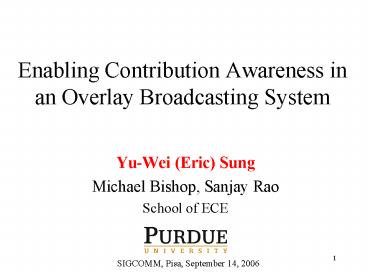Enabling Contribution Awareness in an Overlay Broadcasting System - PowerPoint PPT Presentation
1 / 20
Title:
Enabling Contribution Awareness in an Overlay Broadcasting System
Description:
Upload. Download. Bandwidth Resources. 5. Key Contributions ... Resource-poor hosts are constrained by their upload bandwidth. 8. Our Approach ... – PowerPoint PPT presentation
Number of Views:52
Avg rating:3.0/5.0
Title: Enabling Contribution Awareness in an Overlay Broadcasting System
1
Enabling Contribution Awareness in an
Overlay Broadcasting System
- Yu-Wei (Eric) Sung
- Michael Bishop, Sanjay Rao
- School of ECE
SIGCOMM, Pisa, September 14, 2006
2
Video Broadcast using Overlay Multicast
NYC
Encoder
A/V Signal
E
Boston
D
Ethernet
E
E
Pisa
DSL
D
D
D
San Francisco
Tokyo
E
LA
Overlay Tree
Boston
NYC
Pisa
LA
San Francisco
Tokyo
3
State-of-Art in Overlay Multicast
- Key successes already achieved
- Architecture Validation and Protocol Design
- Narada, Yoid, Overcast, NICE, SplitStream, ALMI,
CoopNet, Bullet - Significant progress on scaling, resiliency
- Real Deployments
- Tmesh (Michigan), CoolStreaming (HK), ESM (CMU)
- Much success to date
- Homogeneous environments with abundant bandwidths
- Can we go further? Is overlay multicast feasible
in mainstream Internet environments?
4
Focus of This Paper
- Heterogeneity in node upload/forwarding
bandwidth - Upload access bandwidth varies widely
- Hosts may choose to forward differently
- Resource-scarce
- E.g. 80 DSL/Cable modem, 20 Ethernet, Src Rate
300Kbps - Insufficient resources to provide full source
rate to all receivers - Critical problem not received enough attention
Bandwidth Resources
5
Key Contributions
- Comprehensive solution to enable overlay
broadcasting in resource-scarce, heterogeneous
environments - Implementation on top of an operational
broadcasting system - Internet study using traces from operational
deployments
6
Talk Outline
- Application Framework and System Design
- Distributed bandwidth allocation policy
- Multi-tree overlay structure
- Experimental Methodology
- Important Results
- Summary
7
How to allocate bandwidth?
- Host i contributes/forwards fi
- Bandwidth actually served to children in the
broadcast - May be less than access bandwidth
- How much bandwidth ri should host i receive?
- Simple policy bit-for-bit ? ri fi , inadequate
since - Resource-rich host can contribute more than src
rate - Resource-poor hosts are constrained by their
upload bandwidth.
8
Our Approach
- Provide support for bandwidth allocation policies
- More generic than bit-for-bit
- Amenable to distributed implementation
- Differential and Equitable Distribution
- ri a fi ( 1a ) ( avg f )
- Motivated by recent work on linear taxation
- Sigcomm 04 PINS workshop
Entitled bandwidth
Contribution
0 lt a lt 1
9
Multiple Overlay Trees Coopnet,SplitStream
- With support from MDC, split into T-equally sized
stripes - T trees, each distributes a single stripe of size
S/T - Overall quality depends on the number of stripes
received - Number of trees node i is entitled to
S Kbps
Source
S/3
S/3
S/3
10
Entitled Bandwidth Example
- S400Kbps, T4, S/T100Kbps, fE500Kbps,
fD100Kbps, avg f 300Kbps,a0.5 - rE0.55000.5300400Kbps ? entitled to 4 trees
- rD0.51000.5300200Kbps ? entitled to 2 trees
Source
100Kbps
100Kbps
100Kbps
100Kbps
E
D
E
E
E
D
11
Excess Bandwidth
- Unused bandwidth may still exist after peers
receive their entitled bandwidth - When found Excess Bandwidth
- Peer D entitled to 2 trees, excess in other trees
Source
100Kbps
100Kbps
100Kbps
100Kbps
E
D
D
E
D
E
E
D
12
Key Design Issues
- Entitled Bandwidth Computation
- ri a fi ( 1a ) ( avg f )
- Distributed global state sampling
- Smoothing entitled bandwidth
- Excess Bandwidth Discovery
- Fair distribution while minimizing oscillation
- Achieved by active probes with Backoff,
Prioritization
13
Evaluation Goals
- How effective are these heuristics in providing
incentives? - Bandwidth
- How stable is the resulting system?
- Time between tree reductions
- Reconnection time
14
Evaluation Methodology
- Playback 20-min segments of real traces on
Planetlab - Use Slashdot to evaluate 2 systems
- Cont-Agnostic multi-tree broadcast system
- Cont-Aware multi-tree contribution-aware
heuristics - S400Kbps, T4, stripe size S/T100Kbps
- 2 types of peers Ethernet fmax 800Kbps, DSL
fmax 100Kbps - HC 700-800Kbps, LC 75-100Kbps
Conferences
Mainstream Internet
15
Performance High Contributors
Better
Cont-Aware gives HC better performance
16
Performance Low Contributors
Better
Better
Similar performance among similar contributors
17
Stability
- Time between Tree Reductions
- Cont-Aware performs slightly worse
- Reductions gt slight dips in quality
- Not complete disconnection, 63.4 from 4?3, 34.1
from 3?2, only 2.5 from 2?1 and 1?0 - Reconnection time (in sec)
18
Performance across traces for high contributors
19
Summary
- Focus Video broadcasting in resource-scarce,
heterogeneous environments - Comprehensive solution to address this challenge
- Leverages two key ideas Multi-trees and Linear
Taxation - Implemented on top of an operational Broadcast
System - Internet study using traces from operational
deployments - Key step to extend overlay broadcasting in
mainstream Internet environments - Future work exploration of resource allocation
policies, cheating of nodes, detecting node
capabilities.
20
- Thank you!
- Questions?































